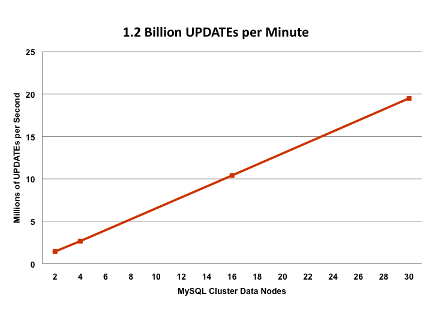digitalpoint
Well-known member
The new version of MySQL Cluster (7.2) has been deemed GA status (stable). For those that aren't familiar with MySQL Cluster, it allows multiple servers to act as a single DB server and is transparent to the application (it's just a different storage engine in MySQL). Any node is fully safe for both reads *and* writes. You define how many nodes you want your data replicated across (so all data is available if nodes go down), and if a node goes down, it instantly starts sharding data to other nodes so it gets back to having at least xx live copies of data. You can also add additional servers/nodes for relatively linear scalability if you need more capacity (you can add nodes without restarting anything).
Long story short... it's very nice.
Some interesting benchmarks on the new version... http://mikaelronstrom.blogspot.com/2012/02/105bn-qpm-using-mysql-cluster-72.html
An 8 data node setup was benchmarked at over 1 billion queries per minute with commodity hardware. Let's break that down... 16.7M queries per second for the DB cluster. Break that down further to individual nodes, and it's still pretty impressive... 2.1M queries per second on average for each server/node within the cluster.
Not just limited to reads (reads are of course faster), but write capacity is impressive as well... doing 1.9M SQL writes (update/insert) per second.
Little summary video: http://www.oracle.com/pls/ebn/swf_viewer.load?p_shows_id=11464419
Long story short... it's very nice.
Some interesting benchmarks on the new version... http://mikaelronstrom.blogspot.com/2012/02/105bn-qpm-using-mysql-cluster-72.html
An 8 data node setup was benchmarked at over 1 billion queries per minute with commodity hardware. Let's break that down... 16.7M queries per second for the DB cluster. Break that down further to individual nodes, and it's still pretty impressive... 2.1M queries per second on average for each server/node within the cluster.
Not just limited to reads (reads are of course faster), but write capacity is impressive as well... doing 1.9M SQL writes (update/insert) per second.
Little summary video: http://www.oracle.com/pls/ebn/swf_viewer.load?p_shows_id=11464419

![31879402[1].webp 31879402[1].webp](https://xenforo.com/community/data/attachments/38/38099-549a8e8ca207b3c9d711eb61a862d316.jpg?hash=VJqOjKIHs8)